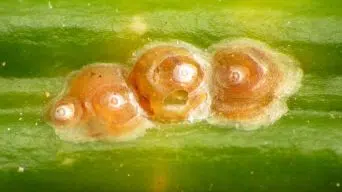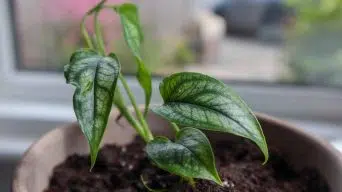Overwatering Monstera plants can lead to issues like root rot, yellow leaves, and fungal diseases. To treat, remove from pot, trim roots, soil, and damaged foliage. Repot in well-draining soil, let it dry and establish a proper watering schedule. Prevention involves checking soil dryness, good drainage, and avoiding excessive watering.
Monsteras, commonly known as Swiss Cheese plants, are popular but delicate houseplants, so caring for them correctly is key.
To ensure your Monstera stays healthy and thriving, it’s important to learn how to recognize an overwatered plant – this can lead to various problems, such as root rot or yellowing leaves, if not taken care of promptly.
In the following, we will look at ways to identify signs that your Monstera has been overwatered, methods for treating it quickly and effectively, and tips for avoiding future occurrences.
What Are the Risks of Overwatering Monstera Plants?
Overwatering Monstera plants can have disastrous effects on their health.
Root rot, a severe problem that, when left untreated, could be fatal to the plant, can occur when its roots sit in water for too long and cause leaves to turn yellow or drop off as well as stems becoming soft and collapsing.
Fungal diseases are also common with overwatering; they attack the leaves and stem of your Monstera, resulting in black or brown patches that will eventually fall away from the plant while rotting any remaining part of it over time – diminishing its ability to endure drought conditions later down the line.
Monstera plants need the perfect balance of water and nutrients to grow comfortably.
Overwatering isn’t just detrimental to a plant’s roots by causing rot and can also heavily influence its growth in other noticeable ways.
Nutrient deficiencies take hold when too much moisture is around – leaves discoloring or dropping off are signs that this could be happening – while excessive waterlogging makes pests and diseases more likely due to weakened stems from stunted growth cycles.
To prevent issues like these, check your Monsteras regularly for any telltale symptoms of overwatering so you can adjust watering habits accordingly!
How Does Overwatering a Monstera Occur?
Monstera plants are typically quite resilient and can adapt to many growing conditions, but overwatering is one of the most common causes of unhealthy Monsteras.
The biggest offender—watering frequency—is easily prevented by waiting until the soil has dried out before adding more water.
You also must pay attention to pot drainage; if there’s no way for excess moisture to escape, your plant will likely become over-hydrated.
Also, be sure not to use excessive water when you come to give them a drink!
Lastly, ensure that whatever mix you’re using allows enough airflow around those fragile roots so they don’t succumb.
What Does an Overwatered Monstera Look Like?
When it comes to caring for a Monstera, overwatering can quickly become an issue. But how do you know if your plant is suffering from too much water?
Certain tell-tale signs indicate when the care routine should be adjusted.
Signs of an Overwatered Monstera
If you suspect your Monstera has been overwatered, examine it closely for the following telltale signs:
Yellow Leaves
If you find your Monstera leaves turning yellow, it could indicate that the plant is overwatered.
The lack of oxygen available to its roots can cause the foliage to discolor and lead to death if not addressed promptly.
To confirm this diagnosis, remove your Monstera from its pot for a closer look at the root system; waterlogged or rotting roots are hallmark signs of an overwrought potting situation!
If your plant’s roots are healthy and strong, another factor could be behind its yellowing leaves. Maybe it lacks essential nutrients or has been disturbed by an insect infestation. So take a closer look to identify the problem!
Drooping Leaves
If you’re seeing droopy leaves on your Monstera, it could be a sign that the plant has been overwatered.
When too much water is present in its soil, the Monstera won’t absorb enough of it and starts to conserve moisture by wilting.
To check for this issue, observe how easily excess water drains out from the bottom of its container. If there’s standing liquid or very little runoff after watering, then chances are you’re giving it more than necessary!
In addition to being overwatered, too much heat stress, nutrient deficiencies & pests are also culprits for droopy foliage.
Pay attention when you spot these signs so that corrective action can be taken promptly and keep those plants happy & healthy!
Brown Spots on Leaves
If you have noticed brown spots appearing on the leaves of your Monstera plant, it could be a sign of overwatering.
When too much water is present in its roots and soil, oxygen cannot reach the plant tissue – causing dark patches to appear on the foliage.
It’s important to check for other indicators such as root rot or pests if this happens so further damage can be prevented.
Nutrient deficiency might also cause similar symptoms – making it essential to provide proper care for your houseplant!
Waterlogged Soil
One of the most recognizable signs that your Monstera may have been given too much water is a soil structure that appears soggy, mushy, or dark in color – this indicates waterlogged earth below their roots.
Furthermore, it’s common for such conditions to present an unpleasant odor as well.
So if you suspect your Monstera might have had one sip too many lately, check up on its soil health before taking further precautionary measures!
Root Rot
Monstera plants can quickly succumb to root rot – a dangerous condition brought on by excessive watering.
Fungal spores flourish in these wet conditions and attack the roots, causing them to decay and lose their ability for nutrient absorption.
Symptoms of this issue include mushy brown or blackened roots that feel soft when touched.
It’s important to act fast if you suspect your Monstera has root rot.
Carefully examine the roots – they should be firm and creamy in color, not brown or black, with a mushy texture.
You can save the plant by pruning away any affected parts before replanting it in fresh soil that drains well.
If too much of the root system is gone, sadly, it’s best to remove this beloved houseplant and start again!
Fungal Growth on the Soil
If your Monstera plant is overwatered, watch out for fungal growth!
It could be either white or gray mold, mildew, or other types of fungi. Not all are bad – some can actually be beneficial to the plants.
But if you detect any hazardous fungus on yours, act quickly and remove affected leaves and stems from it. This will help prevent its spread across the entire foliage.
Additionally, sterilize tools before using them on other plants in order to avoid cross-contamination at all costs; a fungicide may also have to come into play depending on how far along the infection has gone already.
Stems that are Soft or Brittle
If your Monstera’s stems feel soft or brittle, it may be a sign of overwatering.
Nutrients can not properly absorb into waterlogged roots, and the plant’s stems become weak and easily breakable – sometimes even starting to rot!
Supporting them with stakes is key, but you must also review the airflow around it and repotting in a fresh potting mix if needed.
You’ll want to trim away any damaged stem parts so that new growth has an opportunity to flourish once again.
How To Save an Overwatered Monstera Plant
Having an overwatered Monstera plant can be tricky, but there are ways to help get it back on track.
Taking the right steps quickly is important for giving your beloved plant another chance at life!
First Step: Remove the Monstera Plant From the Pot
The first step is to remove the Monstera from the pot to check the roots.
If the roots are soggy or have started to rot, they must be trimmed back.
Rotting roots can spread to the rest of the plant, so it is essential to remove them as soon as possible.
Clean the healthy roots with a rinse of water and allow them to dry before replanting the Monstera.
Second Step: Remove All the Soil
To keep your Monstera flourishing, carefully remove it from the pot.
Then take a look at its roots to ensure they are in good condition. If any have rotted or soft spots appear on them, trim those back as soon as possible – this is necessary so that rot doesn’t spread nearby and damage other parts of the plant.
To finish things off nicely, give the healthy roots a nice rinse with water before planting again!
Third Step: Trim Back the Monstera Foliage
Pruning is the key to giving your Overwatered Monstera a new lease on life!
By trimming back the foliage, you’ll help it focus its energy and vitality where it’s needed most: on healthy areas of growth. This can result in revitalized leaves with a beautiful hue again in no time.
Fourth Step: Check the Drainage
Healthy and thriving Monsteras need well-drained soil to thrive.
Before using a pot for your plant, check if it has drainage holes and ensure they’re unblocked. If not, water could become stagnant at the bottom of the container and starve the roots!
Fifth Step: Repot the Monstera in Fresh Soil
It’s time to give your Monstera a new home! To ensure healthy growth, select soil that drains well and is of high quality.
Add some gravel or river rocks underneath the pot for extra drainage benefits before it’s filled with fresh potting mix – leaving two inches at the top so you can water without overflowing.
Sixth Step: Allow the Monstera Plant to Dry Out
As the final step in caring for your Monstera plant, it is vital to let its soil dry out completely before you water again.
Pick a spot with plenty of bright indirect light and stay away from direct sun – this will prevent any leaf scorching!
Your unique tropical plant friend should be all set up for success at that point.
Seventh Step: Start a Regular Watering Schedule
To keep your Monstera plant thriving, establish a regular watering routine!
When the top inch of soil is dry to the touch, it’s time for some hydration.
Don’t forget to empty out any excess water that collects in its saucer afterward- healthy plants need good drainage too!
Eight Step: Monitor the Monstera Plant
As a rule of thumb, watch your Monstera closely and look for any yellow or browning leaves—signals that it needs less water.
If you notice these signs, reduce the amount given to preserving its health!
With proper care following these steps, an overwatered Monstera can be returned from the brink in no time.
How To Prevent Overwatering a Monstera (Swiss Cheese Plant)
Make sure your Monstera’s health is top notch- knowing when and how much to water them can be the key.
A little bit of knowledge on proper watering habits goes a long way; with just a few simple tips, you’ll have no problem keeping your plant healthy without overwatering!
- Only water Monstera plants when the soil is dry. Use your finger to feel the soil before watering.
- Water slowly and evenly until water runs out of the drainage holes.
- Don’t let your Monstera sit in water. Empty the saucer after watering.
- Check that your pot has good drainage. If it doesn’t, repot into a pot with drainage holes.
- Use a potting soil that drains well. A mixture of potting soil, perlite, and bark works well.
- Don’t water your Monstera more than once a week. In winter, you may only need to water every two weeks.
Watering your Monstera is essential to keeping it healthy—but too much can be detrimental. Follow these tips to ensure you’re striking the perfect balance!
Final Thoughts
Caring for indoor plants has many rewards, but the Monstera is particularly forgiving if you slip up in keeping to a watering schedule.
While overwatering can be common and easy to do unintentionally, it’s important that proper care is taken not just so your plant thrives – but also so that excessive moisture doesn’t cause any root damage or create an environment conducive of pests.
With just a few tips and tricks however, growing beautiful healthy Monsteras at home will soon become second nature!







